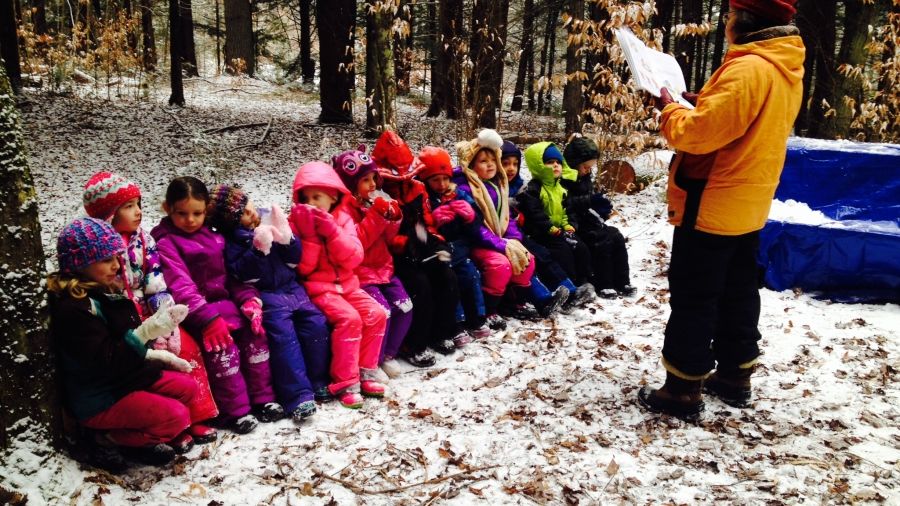
With the rise of academics in early elementary grades, including kindergarten, many teachers and parents are longing for more nature in the classroom (or, more likely, outside the classroom). But are nature-based programs possible in public school settings? Several teachers who I met in the summer of 2013 while teaching a nature-based curriculum course at Antioch University New England have given me new hope that public schools can use the forest as a classroom.
What is a Forest School?
The terms forest kindergarten, nature preschool, and forest school have been used interchangeably in describing programs that provide exploration in nature as a key element of their curriculum. Forest kindergartens and nature preschools are programs that provide young children with extensive time outdoors, often in wild natural settings, such as forests, wetlands, and prairies. These programs usually serve children ages 3-6.
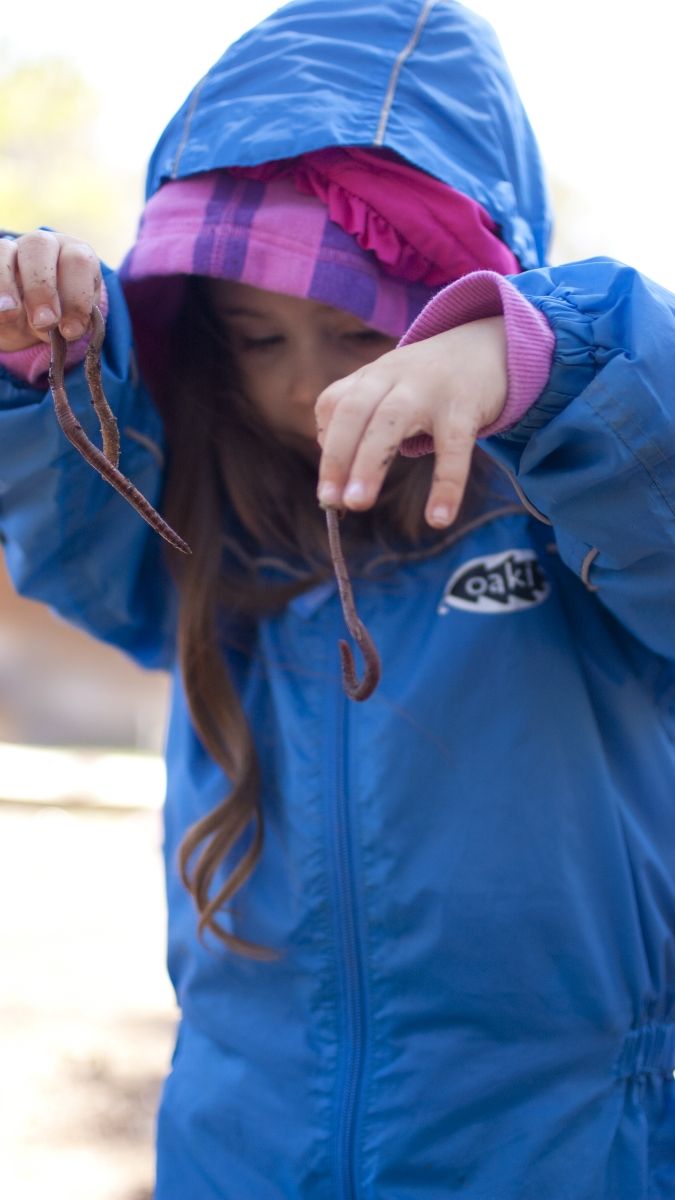
Photo by Chippewa Nature Center Preschool
Forest kindergartens are modeled after the waldkindergartens in Europe where children spend 80-90% of their time outdoors in natural areas. Nature preschools also spend large amounts of time outdoors, and are usually associated with nature centers where children have access to resources that are not typically found at traditional preschools, such as diverse habitats, animals, and naturalists.
In contrast to forest kindergartens and nature preschools, forest schools provide children with a weekly visit to a forest or natural area. If within walking distance of a park or other natural area, children walk to the location on their appointed day. Others travel by minivan or public transportation. Teachers are trained as forest school practitioners, or the school contracts with an organization that has trained forest school practitioners to provide the programs.
A report entitled A Marvelous Opportunity for Children to Learn described forest schools in the United Kingdom as “an inspirational process that offers children, young people and adults regular opportunities to develop confidence through hands-on learning in a woodland environment.” According to the British Forest Schools website, “The philosophy of Forest Schools is to encourage and inspire individuals of any age through positive outdoor experiences." The group explains that "Forest Schools will aim to develop: self awareness, self regulation, intrinsic motivation, empathy, good social communication skills, independence, a positive mental attitude, self-esteem, and confidence.”
Forest Schools in Canada
In 2012, Canada established a forest school network that includes all types of nature-based preschools and kindergartens with a training feature similar to the UK approach. A dozen programs are listed on their website.
Sangster Elementary School Nature Kindergarten in Sooke, British Columbia, is a public school that piloted a program in 2012 where the children spend their mornings outside in a woodland area or nearby beach and their afternoons back at school in the classroom. The school's website explains, “Children could explore their local, natural environment and learn to know and understand their home place, developing confidence in being outside while meeting the objectives of the kindergarten curriculum.”
The school district chose several principles to guide their program, including: connecting deeply with nature through play (environmental stewardship); the environment as co-teacher; learning collaboratively as part of an empathetic community; physical and mental health; and traditional and local ways of knowing and understanding. This last principle referred to the support provided for aboriginal language and ways of learning. The teachers that piloted the program were a nature kindergarten teacher (trained in the UK with experience working at a forest school), an early childhood educator, and a part-time aboriginal support person.
The children spent 2.5 hours in the morning in the Royal Roads University Forest or at the Esquimalt Lagoon. After the first year, the teachers reported positive outcomes of the program including individualized learning, a strong sense of community, and the opportunity for children to work in ways that allowed them to be creative problem solvers. The teachers all agreed that the environment truly acted as a co-teacher. Research studies during the first year of operation were carried out by the University of Victoria and Camosun College. Some of the findings will appear in an article to be published later this year in the Children, Youth and Environments special issue on Greening Early Childhood Education.
Forest Schools in the United States
The development of forest schools in the United States has lagged behind the rest of the world. The first nature preschool in the United States started in 1967 at the New Canaan Nature Center in Connecticut, but the concept didn’t take hold until the late 1990s and early 21st century, with approximately two dozen in existence today. Forest kindergartens are starting to gain ground with several modeling themselves after the European type. However, forest schools (public-school kindergartens that spend time outside on a regular basis with the goal of integrating nature education into the curriculum) are few.
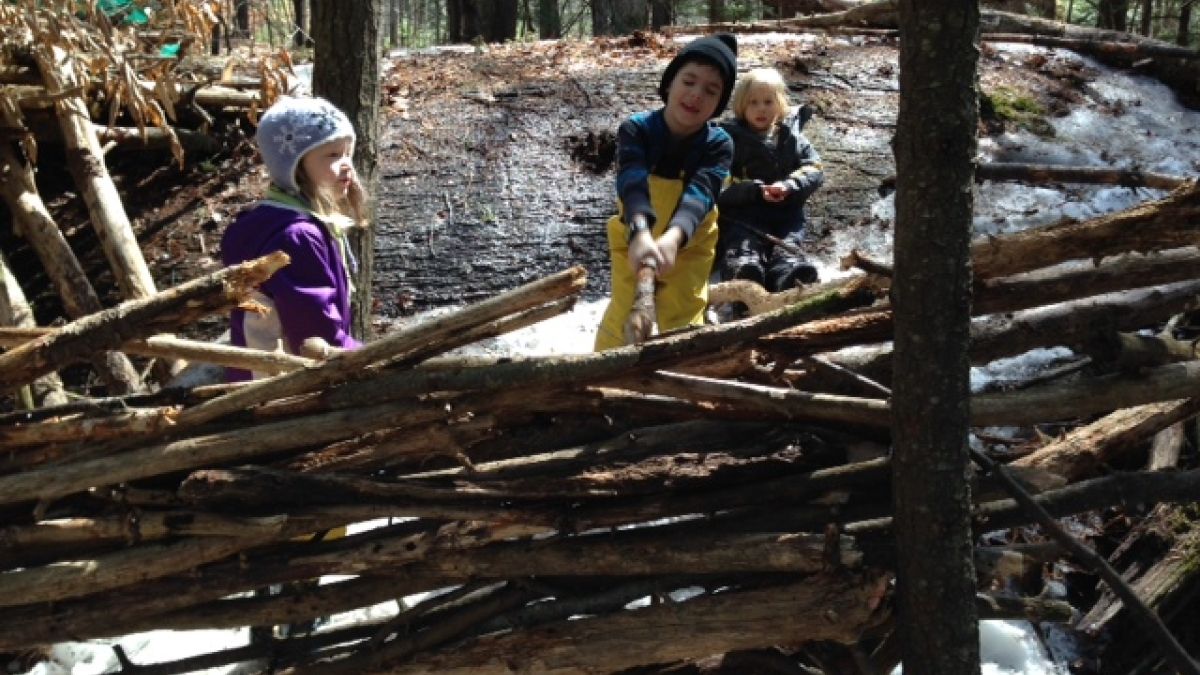
Photo by Eliza Minnucci
Even so, there are two new programs that have been incorporating nature into their curriculum this past year, both in Vermont. Kindergarten teacher Eliza Minnucci started a program at the Ottauquechee School in Quechee, Vermont, with assistant teacher Meghan Teachout. The goal of the program is to spend every Friday outside in a forest. They call it Forest Friday and in the words of the teachers, they “use the woods, almost all day, in all kinds of weather, as an alternative classroom.” They build a fire every Friday, construct structures including an igloo, explore in sunshine and downpours, while finding ways to integrate math, literacy, and science into the forest activities.
However, the program has not been without its challenges. Minnucci reflects, “I think one of our biggest struggles has been finding the right balance between teacher-directed and student-directed time.” One of the most important features of a forest kindergarten is the unstructured nature play that occurs when the children are exploring the forest and other habitats. But as Minnucci explains, “Unlike many emergent preschool curricula, so much of elementary teaching these days is chunked into small pieces and designed with specific learning goals in mind by curriculum publishers and teachers alike. . . . As the year progresses, though, I’m feeling better and better at going with the flow in the woods.”
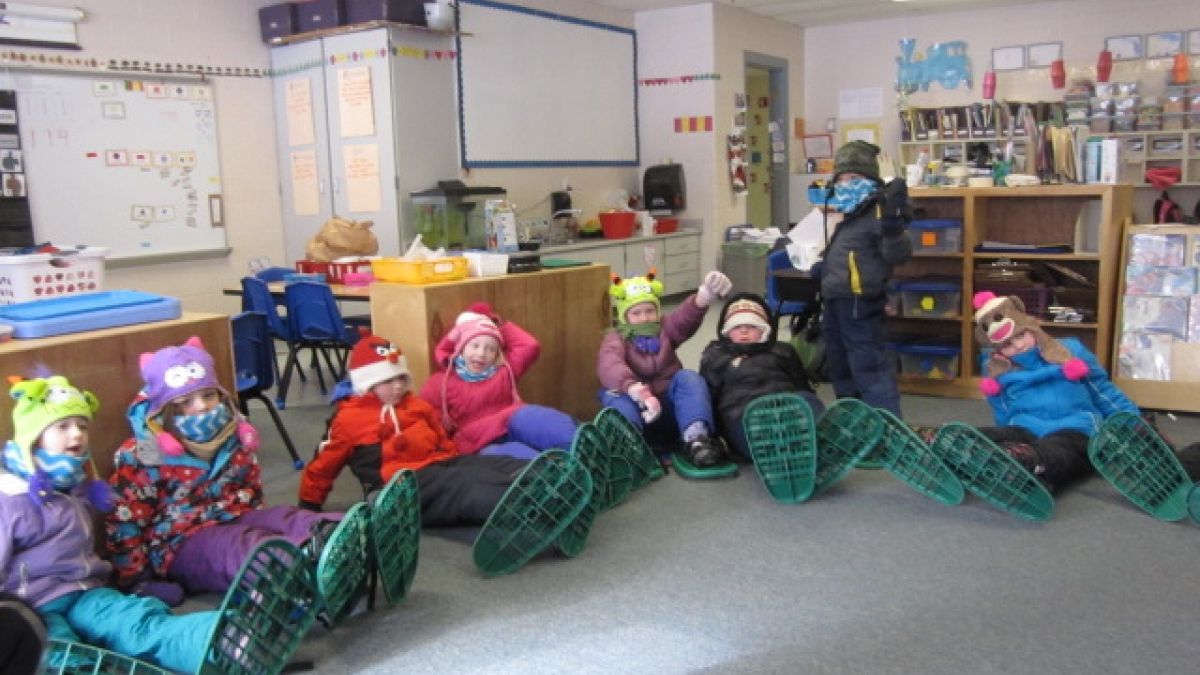
Photo by Eliza Minnucci
She has found that she is able to meet many of the curricular goals and Common Core standards through the outdoor program. But of equal importance is the social growth she has seen in her students. “The opportunity for teamwork and the necessity of solving problems independently is not replicable in the close, controlled classroom setting. . . . Interpersonal relationships in the woods are more successful than in the classroom, despite (or because of) the increased freedom and decreased supervision. . . . The opportunity for some kids to be experts in a way they aren’t in the classroom is very supportive of academic goals, because their confidence outdoors translates into effort indoors.”
Minnucci has set up a blog detailing the class's Forest Friday adventures and she is keen to share her experiences with anyone who is interested in pursuing this type of program ([email protected]).
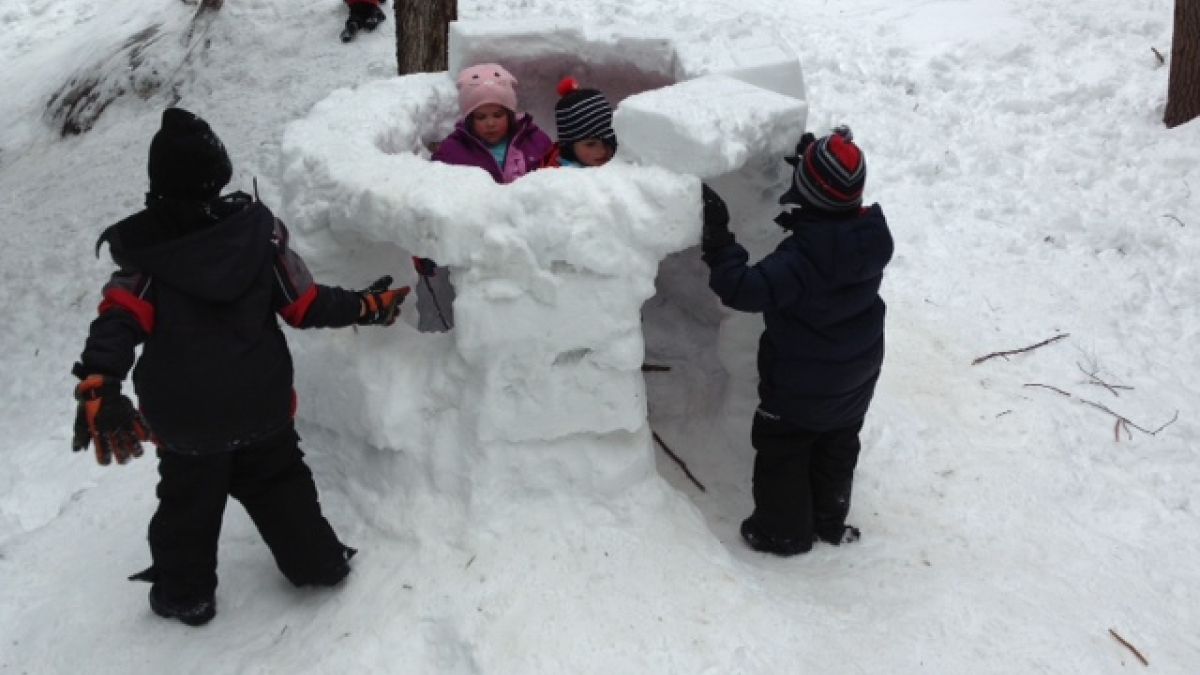
Photo by Eliza Minnucci
Elizabeth Feinberg is a kindergarten teacher at Bethel Elementary School in Bethel, Vermont. She, Eliza Minnucci, and Meghan Teachout were participants in a nature-based early childhood curriculum course I taught at Antioch University New England in the summer of 2013. This course was the first in the series now being offered in the Nature-Based Early Childhood Certificate Program at Antioch. Their purpose in taking the course was to develop a forest kindergarten program at their public schools. Minnucci and Teachout had a plan from the beginning for the Forest Fridays and were in the process of applying for grant funding.
Feinberg was somewhat overwhelmed with the prospect, feeling that this approach would be difficult in a public school setting (as many kindergarten teachers in public schools certainly feel). As she worked through the coursework and talked with other students in the class, though, she began to realize that she could implement a program by taking “baby steps” along the way. The baby steps she identified included starting the day outside once a week (as the children played outside already prior to school starting) and possibly having their group meeting outside. When the weather was nice enough, they might even take a hike in a nearby natural area or plan a unit (such as butterflies) with an outdoor component.
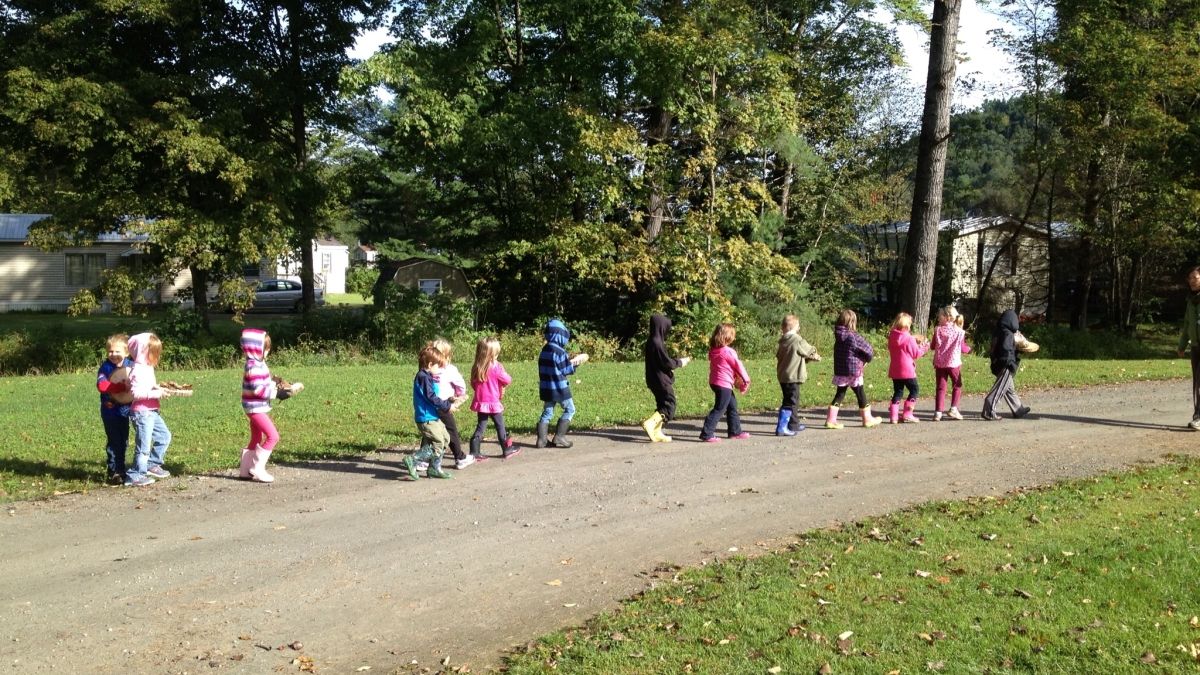
Photo by Elizabeth Feinberg
Feinberg realized that the right clothing would be needed, so she found funding to purchase mud boots for all the children in her class. She also asked parents to sign up to volunteer to assist with hikes. She calls the outings "Science Hike Mondays" and the class spends at least 1-2 hours outside hiking once a week. She says, “I have LOVED the nature hikes. It has created a community for us. . . . It provides wonderful parent/child interaction because so many join us each week.” She finds that Common Core State Standards also are being met, with students working on skills such as measuring, counting, listening, and speaking. Her class tells stories as they sit on tree cookies outside. They’ve used snowshoes on the ice and snow this year. “The kids were marvelous. . . . They ran, they shouted, they maneuvered. . . . All I could think as they were showing their stuff, was, Wow! If I hadn’t taken that Nature Preschool class last summer I never would have done this.”
Where Do We Go From Here?
So why aren’t there more forest kindergartens in public schools? The idea seems to be spreading, but resources and training can be expensive and the teacher-to-student ratio needs to be lower than in typical kindergarten classrooms. Grant funding was required to support the early childhood educator in Sooke, British Columbia, and the assistant teacher in Quechee, Vermont. Unlike the tuition-based forest kindergartens and nature preschools at private schools and nature centers, public schools can’t charge tuition.

Photo by Eliza Minnucci
And to have an effective program, in addition to being certified to teach kindergarten, the teachers need additional training that includes risk assessment, natural history, and curriculum design for outdoor settings. Not all school boards are convinced of the benefits of this type of training. But parents see the benefit of this program for their children: In British Columbia, parents actually camped out overnight to register their children for the forest kindergarten program.
If you’ve started a nature kindergarten in a public school, share your story in the comments section below, or let the Natural Start Alliance know about your program so we can begin to collaborate with each other and find the support needed to develop this in schools throughout the country. As David Bly, a supporter of the Sangster Elementary School Nature Kindergarten in British Columbia, wrote in an editorial in the Times Colonist, “every kindergarten should be a nature kindergarten."
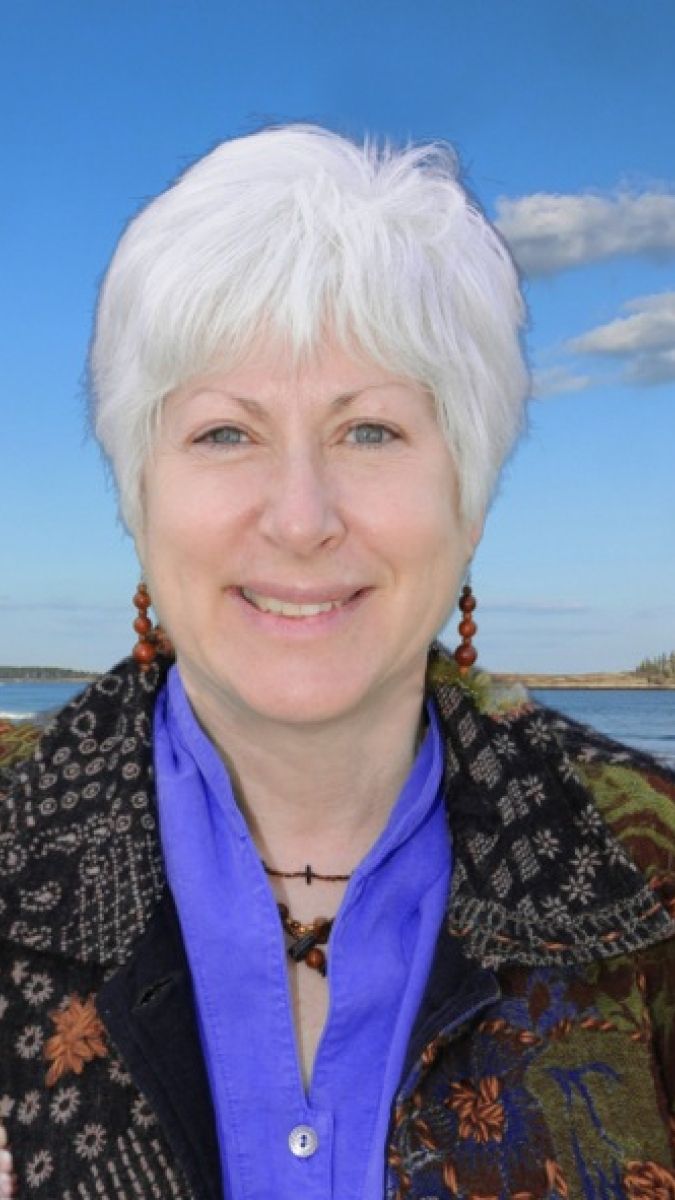
About the Author
Patti Ensel Bailie, PhD, is the Assistant Director of the Nature-based Early Childhood Certificate Program at Antioch University New England and founding director of the Schlitz Audubon Nature Preschool in Milwaukee, WI. She has worked in the field of early childhood environmental education for over 20 years. ([email protected]).